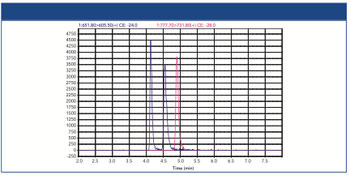
- The Application Notebook-09-01-2020
- Volume 38
- Issue 9
Wyatt Technology - RT-MALS Endpoint Determination of a Polysaccharide Depolymerization Process
Introduction
Molar mass plays an important role in the solubility, potency, and stability of polysaccharide-based vaccines. The production process includes a critical depolymerization step to reduce the polysaccharide’s initial weight-average molar mass, Mw, from over 1800 kDa to less than 350 kDa.
Current methods to monitor molar mass during polysaccharide production employ offline SEC-MALS analysis, during which a single run can take up to 30 min. With a typical depolymerization time of about 90 min, offline analytics cannot provide timely feedback on reaching the endpoint. Realtime multiangle light scattering (RT-MALS) fills this need, and ensures that the process ends as soon as the endpoint criterion is achieved.
Materials and Methods
A polysaccharide solution was depolymerized by ultrasonication at 20 kHz. Molar mass was monitored online, in near-realtime, by continuously pumping a small fraction of solution from the reactor through an ultraDAWN RT-MALS instrument (Wyatt Technology) by means of a quaternary HPLC pump.
The solution was diluted continuously by a factor of 10 in order to reduce viscosity for flow through capillary tubing. The flow rate was 5 mL/min, resulting in a lag time (RTD, residence time delay) of just 3 min between the time product was pulled from the reactor and the time of measurement. OBSERVER software was configured to control the HPLC pump, acquire data from the ultraDAWN, calculate Mw 30 times per min, and send a trigger to stop the sonication when Mw is less than 350 kDa as determined by the release specifications.
Results and Discussion
RT-MALS demonstrably tracked reduction of the polysaccharide’s Mw and triggered reaction shutdown once it fell below 350 kDa. SEC-MALS analysis of the final product confirmed the desired critical quality attribute (CQA) value. Multiple off-line analyses were eliminated, the time spent by the drug substance in this portion of the process was cut by 25%, and total person-hours spent in this part of the process was reduced by at least 50%.
Conclusions
Polysaccharide antigens are high-value add products with substantial cost benefits gained by in-process determination of the primary attribute impacted by the specific process. Here, the goal of the depolymerization process is to modify the polymer’s molecular weight, so the ability to determine molecular weight in near-realtime via RT-MALS reduces uncertainties due to process drift or variations in raw material properties, resulting in perfect depolymerization with every run and appreciable cost savings.
Wyatt Technology Corp.
6330 Hollister Avenue
Santa Barbara, CA 93117-3115
Website: www.wyatt.com
Articles in this issue
Newsletter
Join the global community of analytical scientists who trust LCGC for insights on the latest techniques, trends, and expert solutions in chromatography.


